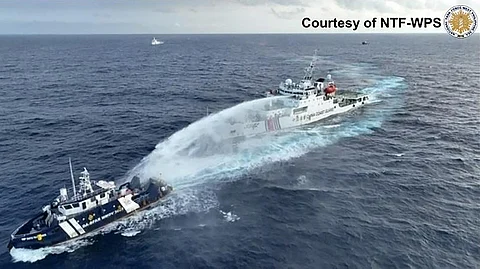
- NEWS
- the EDIT
- COMMENTARY
- BUSINESS
- LIFE
- SHOW
- ACTION
- GLOBAL GOALS
- SNAPS
- DYARYO TIRADA
- MORE

The China Coast Guard fired a water cannon at a Philippine vessel Wednesday morning during a maritime patrol near the disputed Scarborough Shoal (Bajo de Masinloc), according to the National Security Council (NSC).
The Chinese ship “fired a water cannon at the BRP Datu Pagbuaya, aiming directly at the vessel’s navigational antennas,” Philippine Coast Guard spokesperson for the South China Sea, Commodore Jay Tarriela, said in a statement, adding that it then “intentionally sideswiped” the ship before launching a second water cannon attack.
China’s Coast Guard (CCG) said the PCG ship came “dangerously close” to its own in a confrontation in the contested South China Sea.
“Philippine coast guard ships... came dangerously close to regular law enforcement patrol vessels of the China Coast Guard,” a spokesperson said, adding that “China exercised control over them in accordance with the law.”
The PCG and the Bureau of Fisheries and Aquatic Resources (BFAR) were conducting a joint routine maritime patrol at Bajo de Masinloc when they encountered the China Coast Guard (CCG) vessels at around 6:30 a.m. on 4 December.
Tarriela said the CCG ships with bow numbers 5303, 3302, and 3104 intentionally attacked the BFAR’s Datu Pagbuaya — the third ship of the Datu Cabaylo class of 30-meter multi-mission offshore civilian patrol vessels.
“During this operation, our vessels encountered aggressive actions from several CCG vessels, specifically CCG 5303, 3302, 3104, as well as People’s Liberation Army Navy vessels with bow numbers 500 and 571,” he said.
Tarriela described the CCG’s maneuvers as a “hostile action.”
At around 6:30 a.m. on Wednesday, CCG vessel 3302 fired a water cannon at the BRP Datu Pagbuaya aiming directly at the vessel’s navigational antennas while it was located 16 nautical miles south of Bajo de Masinloc.
Intentionally sideswiped
He said CCG 3302 intentionally sideswiped the Datu Pagbuaya on its starboard side.
At 6:55 a.m., CCG 3302 launched a second water cannon attack on the BFAR vessel.
Meanwhile, China gray ships People’s Liberation Army Navy (PLAN) 500 and CCG 503 simultaneously blocked and shadowed the PCG’s BRP Teresa Magbanua.
The Chinese ships also maneuvered dangerously close to the PCG vessel.
At a distance of 300 yards, the CCG 3104 “recklessly” maneuvered against the PCG’s BRP Cabra.
“The PCG and BFAR reaffirm their commitment to protect the rights and safety of our fishermen within our maritime jurisdiction,” the NSC said.
Tarriela lambasted anew China’s illegal claim to Bajo de Masinloc, stressing it has no jurisdiction over the feature that is “classified as a rock” under the 2016 Arbitral Award and Article 121 of the United Nations Convention on the Law of the Seas (UNCLOS).
“The Philippines has sovereignty over it, including its territorial sea,” he said.
Tarriela reiterated that the waters beyond Bajo de Masinloc’s 12-nautical mile territorial sea fall within the Philippine exclusive economic zone (EEZ), measured from the Luzon baseline.
“Consequently, the PCG and BFAR vessels were legitimately patrolling our waters, while it was China that was encroaching in them and militarizing the area by deploying PLA Navy vessels to shadow PCG operations,” Tarriela pointed out.
“The dangerous maneuvers and water cannon harassment by the CCG are not standard law enforcement actions. Rather, they should be interpreted as unlawful aggression by international law violators,” he said.
